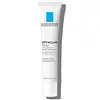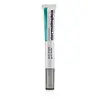What's inside
What's inside
 Key Ingredients
Key Ingredients

 Benefits
Benefits

 Concerns
Concerns

 Ingredients Side-by-side
Ingredients Side-by-side

Benzoyl Peroxide 5.5%
Water
Skin ConditioningIsostearyl Alcohol
EmollientGlycerin
HumectantPentylene Glycol
Skin ConditioningSilica
AbrasiveCarbomer
Emulsion StabilisingCapryloyl Salicylic Acid
ExfoliatingPotassium Hydroxide
BufferingTocopheryl Acetate
AntioxidantAcrylates/C10-30 Alkyl Acrylate Crosspolymer
Emulsion StabilisingDisodium EDTA
Epilobium Angustifolium Flower/Leaf/Stem Extract
Skin ConditioningWater
Skin ConditioningButylene Glycol
HumectantHamamelis Virginiana Water
AstringentIsopropyl Lauroyl Sarcosinate
Skin ConditioningNiacinamide
SmoothingPropanediol
SolventSalicylic Acid
MaskingPolyacrylate Crosspolymer-6
Emulsion StabilisingCaprylyl Methicone
Skin ConditioningGlycereth-26
HumectantSaccharide Isomerate
HumectantHexylresorcinol
AntimicrobialSalvia Sclarea Oil
MaskingMalic Acid
BufferingAloe Barbadensis Leaf Extract
EmollientSalvia Sclarea Extract
AntiseborrhoeicLavandula Angustifolia Oil
MaskingCitrus Limon Peel Oil
MaskingRosmarinus Officinalis Leaf Oil
MaskingLavandula Hybrida Oil
EmollientSclerotium Gum
Emulsion StabilisingSodium Carrageenan
Emulsion StabilisingThymol
AntimicrobialTerpineol
MaskingPullulan
Lecithin
EmollientGlycerin
HumectantDimethyl Isosorbide
SolventPEG-12 Dimethicone/PPG-20 Crosspolymer
Xanthan Gum
EmulsifyingSodium Citrate
BufferingEthylhexylglycerin
Skin ConditioningTetrasodium Glutamate Diacetate
Silica
AbrasiveTocopherol
AntioxidantSea Salt
AbrasivePotassium Sorbate
PreservativeSodium Benzoate
MaskingSodium Hydroxide
BufferingCitric Acid
BufferingBenzoic Acid
MaskingAminomethyl Propanol
BufferingLimonene
PerfumingLinalool
PerfumingPhenoxyethanol
PreservativeWater, Butylene Glycol, Hamamelis Virginiana Water, Isopropyl Lauroyl Sarcosinate, Niacinamide, Propanediol, Salicylic Acid, Polyacrylate Crosspolymer-6, Caprylyl Methicone, Glycereth-26, Saccharide Isomerate, Hexylresorcinol, Salvia Sclarea Oil, Malic Acid, Aloe Barbadensis Leaf Extract, Salvia Sclarea Extract, Lavandula Angustifolia Oil, Citrus Limon Peel Oil, Rosmarinus Officinalis Leaf Oil, Lavandula Hybrida Oil, Sclerotium Gum, Sodium Carrageenan, Thymol, Terpineol, Pullulan, Lecithin, Glycerin, Dimethyl Isosorbide, PEG-12 Dimethicone/PPG-20 Crosspolymer, Xanthan Gum, Sodium Citrate, Ethylhexylglycerin, Tetrasodium Glutamate Diacetate, Silica, Tocopherol, Sea Salt, Potassium Sorbate, Sodium Benzoate, Sodium Hydroxide, Citric Acid, Benzoic Acid, Aminomethyl Propanol, Limonene, Linalool, Phenoxyethanol
 Reviews
Reviews

Ingredients Explained
These ingredients are found in both products.
Ingredients higher up in an ingredient list are typically present in a larger amount.
Glycerin is already naturally found in your skin. It helps moisturize and protect your skin.
A study from 2016 found glycerin to be more effective as a humectant than AHAs and hyaluronic acid.
As a humectant, it helps the skin stay hydrated by pulling moisture to your skin. The low molecular weight of glycerin allows it to pull moisture into the deeper layers of your skin.
Hydrated skin improves your skin barrier; Your skin barrier helps protect against irritants and bacteria.
Glycerin has also been found to have antimicrobial and antiviral properties. Due to these properties, glycerin is often used in wound and burn treatments.
In cosmetics, glycerin is usually derived from plants such as soybean or palm. However, it can also be sourced from animals, such as tallow or animal fat.
This ingredient is organic, colorless, odorless, and non-toxic.
Glycerin is the name for this ingredient in American English. British English uses Glycerol/Glycerine.
Learn more about GlycerinSilica, also known as silicon dioxide, is a naturally occurring mineral. It is used as a fine, spherical, and porous powder in cosmetics.
Though it has exfoliant properties, the function of silica varies depending on the product.
The unique structure of silica enhances the spreadability and adds smoothness, making it a great texture enhancer.
It is also used as an active carrier, emulsifier, and mattifier due to its ability to absorb excess oil.
In some products, tiny microneedles called spicules are made from silica or hydrolyzed sponge. When you rub them in, they lightly polish away dead skin layers and enhance the penetration of active ingredients.
Learn more about SilicaWater. It's the most common cosmetic ingredient of all. You'll usually see it at the top of ingredient lists, meaning that it makes up the largest part of the product.
So why is it so popular? Water most often acts as a solvent - this means that it helps dissolve other ingredients into the formulation.
You'll also recognize water as that liquid we all need to stay alive. If you see this, drink a glass of water. Stay hydrated!
Learn more about Water